Posts Tagged 20th century
A Piano with a Past

Talented African American jazz pianists played this piano at Detroit’s Club Harlem during the mid-1930s. How did the piano acquire its ivory finish? A few years after Club Harlem closed, the Warblers moved to Allen Park. The piano went with them. Perhaps the ivory lacquer was added by Maurine Warbler—a more appropriate look, perhaps, for a piano that now resided in a suburban home THF166445 (From the Collections of The Henry Ford. Gift of Allene Warbler in Remembrance of Her Parents Allen and Rene Warbler.)
The quiet ivory exterior of this unassuming little piano belies its jazz-infused past. Hidden beneath the ivory lacquer are glimpses of silver that offer a clue to its former life. Not only did this piano have a “front row seat” at one of the many jazz clubs that dotted Detroit’s Paradise Valley district during the 1930s and 1940s—it was part of the show.
In March 1934, this piano left the Wurlitzer company’s DeKalb, Illinois factory for its new destination—Detroit. It was delivered to a jazz club called Club Harlem, housed in the basement of the Lawn Apartment building on Vernor at Brush. To give the piano an appropriately “jazzy” look, the club’s managers painted over the piano’s rather reserved mahogany factory finish with aluminum paint. The back of the piano—the side visible to the audience—was covered with black velvet, decorated with large glittery musical notes. The piano’s small size—only 61-keys instead of the standard 88—was likely an asset to upstart Club Harlem in what may have been tight quarters filled with patrons in this basement nightclub. Too, its small size made it more affordable than a standard upright piano. Detroit’s economy was only beginning its slow and uneven recovery from the depths of the Depression.
More Alcohol, More Jazz
The timing of this new club’s opening in early 1934 was no accident. Prohibition had ended the previous December—it was again legal to manufacture, sell and transport intoxicating beverages in the United States. During the 13 years that prohibition had been in force, “underground” establishments had continued to discreetly serve patrons liquor, as well as often offering food and live shows. Now they could do it openly.
During the 1920s, jazz, a musical form rooted in the African American experience, had taken America—and the world—by storm. The fresh, lively sound of jazz was different than anything that had come before. It was the perfect “accompaniment”—in fact, helped define—this more modern era. A 1919 song, Take Me to the Land of Jazz, captured things perfectly with these lyrics, “How in every cabaret, it’s the only thing they play.”
Detroit's Paradise Valley
During the 1930s, a commercial center emerged in an area of Detroit (bounded by Gratiot, Vernor, Brush and Hastings streets) that became known as Paradise Valley. Racial discrimination had sequestered the city’s African American population into a tight-knit and vibrant community on Detroit’s near east side. Here, black-owned businesses dotted the streets and Detroit’s African American community could shop, eat, and enjoy their leisure time. Paradise Valley--with its clubs, theaters and dance halls—would become the major entertainment spot in Detroit, as a growing number of nightspots offered places where jazz could be enjoyed. Talented African American musicians and singers, including Billie Holiday, Duke Ellington, and Louis Armstrong, lit up the nights. Paradise Valley experienced its most rapid growth after Prohibition ended in 1933, with many jazz clubs--including Club Harlem--added during the following decade.
During the day, Paradise Valley was predominantly Black. At night and into the wee hours of the morning, Paradise Valley became more racially balanced, as many white Detroiters sought the entertainment opportunities found there. A major factor was the development of the black-and-tan nightclub, which catered to both African American and white audiences. Club Harlem, located at the northern boundary of Paradise Valley, was one of these black-and-tan jazz clubs. Many of the black-and-tan clubs in the district were owned by African American businessmen. A few, like Club Harlem, were owned by whites.
Club Harlem
Club Harlem’s owner was Morris Wasserman. Wasserman ran a loan business and owned a pawn shop. (It was said that Wasserman also had ties to Detroit’s notorious Purple Gang, criminals involved in the illegal liquor trade during Prohibition.) Wasserman hired Allen Warbler to manage the club. Warbler had previously worked for Jean Goldkette, a prominent band organizer and booking agent, at Goldkette’s popular Detroit ballroom, the Graystone, during its heyday of the 1920s. Warbler's wife, Maurine, who had worked for a theatrical booking agent, designed many of the costumes worn by the chorus performers at Club Harlem.
Among the performers who played Club Harlem was 19-year-old Milt Buckner. Orphaned at the age of 9 and adopted by members of Earl Walton’s band, Milt and his brother Ted were prominent jazz musicians in 1930s Detroit. A few years later, Milt Buckner would join Lionel Hampton’s band as pianist and key music arranger. Bands headed by Monk Culp and Ernest Cooper also played Club Harlem. Other musicians who entertained Club Harlem’s audiences were 23-year-old saxophone player Charles “Tubby” Bowen, who would later lead a band under the name Tubby Bowen and His Tubs, and 25-year-old Sammy Price, a Texas pianist who became the house pianist for Decca Records in New York City in 1938, recording with many of New York’s jazz and blues greats.
Club Harlem had a short run--it operated from just 1934 to 1935. Club Harlem’s piano, once played by musicians like Milt Buckner and Sammy Price, ended its jazz career. Allen Warbler, Club Harlem’s manager, went into the real restate business. Club Harlem’s owner, Morris Wasserman, would open the Flame Show Bar on John R in Detroit in 1949. The Flame Show Bar would become one of the city’s major jazz clubs during the 1950s.

Pianist Sammy Price in a publicity shot from the mid-1930s THF249299. (From the Collections of The Henry Ford. Gift of Allene Warbler in Remembrance of Her Parents Allen and Rene Warbler.)

These young women were likely dancers in Club Harlem’s “Shim Sham Shimmy” chorus THF249293 (From the Collections of The Henry Ford. Gift of Allene Warbler in Remembrance of Her Parents Allen and Rene Warbler.)
Farewell to Paradise Valley
From the 1930s into the early 1950s, Paradise Valley bustled. But, in the 1950s and 1960s, urban renewal projects designed to “modernize” the city while eradicating “blight,” along with freeway construction for I-75, erased this vibrant African American community—scattering its inhabitants. Little remained of Paradise Valley and neighboring Black Bottom (named by French explorers for its rich soil), where the majority of Detroit’s African American community resided in rundown clapboard houses built to house the flood of German immigrants who arrived in the 1850s. No efforts were made by the city to support the relocation of the African Americans who had resided there. Detroit’s urban renewal projects—and their devastating effect on this community—helped fuel the growing resentment against racial discrimination that would culminate in the 1967 Detroit civil unrest.
A little of Paradise Valley hung on for a few decades, though. The 606 Horse Shoe Lounge was the last remaining nightclub from the glory days of Detroit’s Paradise Valley. The club was located at 606 E. Adams from the 1930s to the 1950s. It had featured a floor show, an orchestra, and its owner John R. “Buffalo” James as emcee. Construction of the I-75 freeway forced the club to relocate to 1907 N. St. Antoine by the early 1960s. This last vestige of Paradise Valley’s legendary jazz clubs was demolished in 2002, the building razed as part of the Ford Field construction.

The 606 Horse Shoe Lounge was the last remaining nightclub from Detroit’s legendary Paradise Valley THF166450 (From the Collections of The Henry Ford. Gift of Arthur A. Jadach.)
Jeanine Head Miller is Curator of Domestic Life at The Henry Ford.
20th century, 1930s, popular culture, musical instruments, music, Michigan, Detroit, by Jeanine Head Miller, African American history
The Search for Home
Detroit Reacts to the Great Migration: Before the first World War, a majority of Detroit's African American population lived on the East Side and shared the area, known as Black Bottom, with white immigrant populations. At this time, relatively few African Americans, just 1.2% of the total population, called Detroit home. By 1930, the city’s African American population had grown by over 1,991%. The white immigrant population began to vacate the Black Bottom area and were quickly replaced with the growing population of African Americans attracted to the north by the promise of employment in Detroit’s booming auto industry and an escape from the rampant oppression of the south. As the African American population in Detroit increased, racial residential boundaries began to form, due in part to the stress on housing stock, as well as to outright discrimination in institutions such as employment and real estate.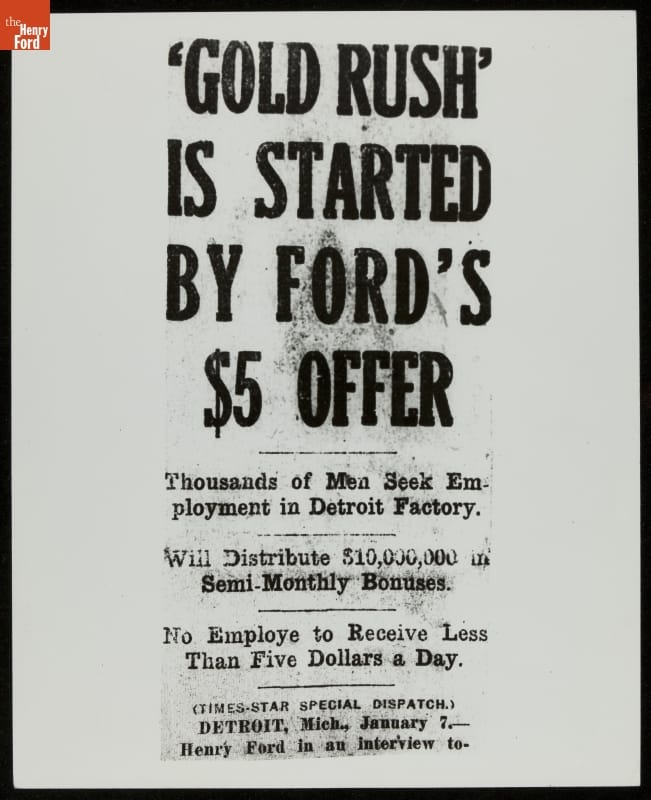
Photographic print - "Newspaper Article, "Gold Rush is Started by Ford's $5 Offer," January 7, 1914" - Ford Motor Company
The automobile industry and Henry Ford’s highly-publicized $5-a-day helped to draw people in great numbers to the Detroit area. However, for African American workers, reality often differed from their hopes and expectations in the north. While many of the automotive manufacturers did hire African Americans, it was almost always for the lowest paying jobs, such as in the janitorial department or the foundry. Ford Motor Company led the automotive industry in its hiring of African American workers by 1919. The company paid African American workers the same rate as their white counterparts and hired for a variety of positions, including skilled labor. Across the board, however, African American workers made less money than their white counterparts, and consequently, had less income for quality housing.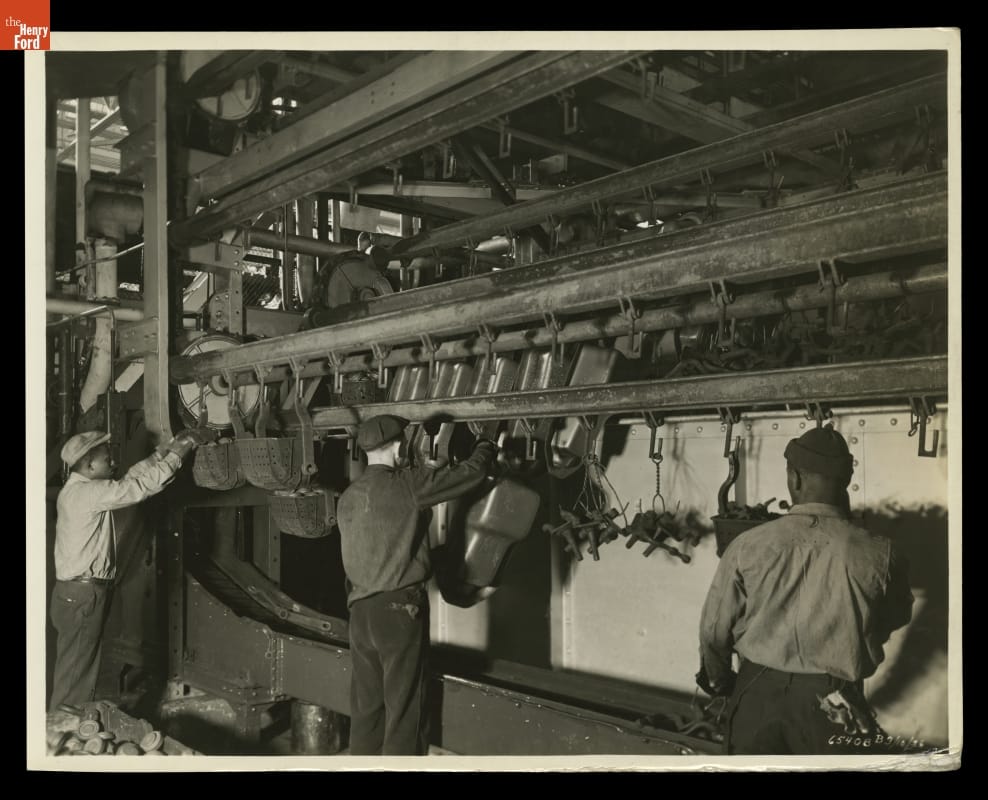
Photographic print - "Pickling Metal Crankcases and Other Parts to Remove Surface Impurities, Ford Rouge Plant, 1936" - Ford Motor Company Photographic Department
Discriminatory real estate practices played a significant role in the housing issues which plagued Detroit. Racially restrictive covenants, which legally ensured the sale of property to only white buyers, became increasingly common in Detroit. Even if a restrictive covenant was not in place, the Detroit Real Estate Board warned area realtors “not to sell to Negroes in a 100 percent white area,” thereby enforcing and perpetuating Detroit’s racial geography. Further, the practice of “redlining,” or the racial categorization of areas by their perceived financial risk in home insurance and mortgage lending, effectively shut out black homebuyers from the market. The practice extended to the lending of new mortgages, but also to home loans, leading to the inability to complete home repairs and, eventually, an abundance of blighted homes in black neighborhoods. In addition, real estate agents erroneously reported to white homeowners that the presence of black families in their neighborhoods would lower their property values. White homeowners, even those without ingrained prejudices against African Americans, certainly did not want their property values to lower, so rallied against any attempt by an African American homebuyer purchasing in their neighborhoods. The infamous story of African American Physician Dr. Ossian Sweet exemplifies the discrimination and mob violence experienced by those who attempted to move into white neighborhoods.
Discrimination in the workplace meant that African Americans, as a whole, made significantly less money than their white counterparts. Redlining practices forced them into racially-segregated neighborhoods and cemented their inability to access loans for mortgages or home repairs. Yet, the promise of the north continued to draw African Americans to Detroit. Without access to capital, increasingly-crowded neighborhoods became increasingly-deteriorated. At each turn, discriminatory systems excluded an entire population from quality housing. From these conditions, Charles H. Lawrence and his family departed Detroit in search of quality housing and a better life. He became the first African American to settle in Inkster, Michigan, and hundreds soon followed.
African Americans Settle in Inkster
The City of Inkster, also located in Wayne County, is approximately fourteen miles from downtown Detroit. Detroit Urban League President John Dancy fielded many housing inquiries from frustrated African American migrants to Detroit in the post-World War I period and beyond. Unable to locate sufficient housing in the City of Detroit, Dancy broadened his search outside the City with hopes that more rural areas would not have the same restrictive covenants and that lesser demand would persuade landowners to sell to African American buyers. In 1920, Dancy succeeded when he found amenable property owners in possession of 140 acres in rural Inkster. Although Inkster’s first African American residents’ settlement in Inkster preceded Dancy’s discovery, the 140 acres of available land enabled and impelled hundreds more African American families to move from Detroit to Inkster, despite the lack of a local government or basic public amenities like streetlights or sewer lines.
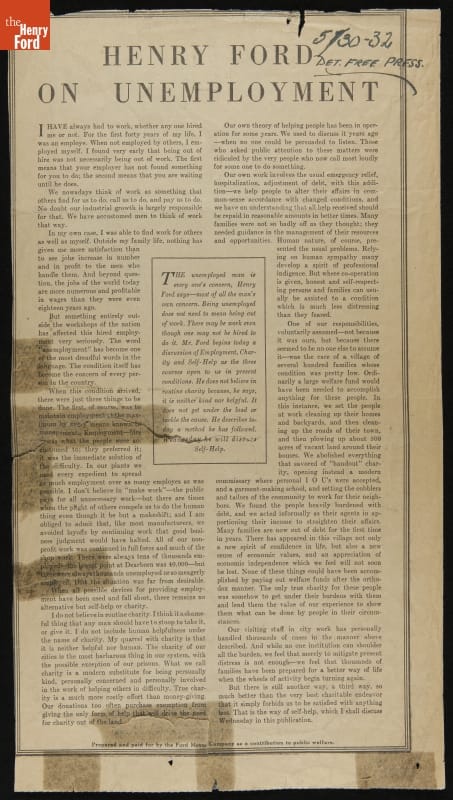
Clipping (Information artifact) - ""Henry Ford on Unemployment," 1932" - Detroit Free Press (Firm)
A Community Becomes a Project
Henry Ford was vocal about his disdain for institutionalized philanthropy. He wrote an entire chapter, entitled “Why Charity?” in an autobiography, and explained, “philanthropy, no matter how noble its motive, does not make for self-reliance…A philanthropy that spends its time and money in helping the world to do more for itself is far better than the sort which merely gives and thus encourages idleness.” Henry Ford’s brand of philanthropy was characterized by helping people help themselves. During the Great Depression, Henry Ford was called upon by the City of Detroit to provide aid because the City’s welfare offices were overwhelmed. Their argument, aside from civic responsibility, was that the City was not receiving taxes from Ford Motor Company (FMC’s factories were located outside Detroit) yet as many as “36 percent of the families receiving care from the City of Detroit were former Ford employees” in 1931. The public goodwill that Ford’s $5 a day policy brought was quickly dissipating. In 1931, Ford agreed to two philanthropic ventures; he provided a low-interest, short-term $5 million loan to the City of Detroit and essentially took the then-Village of Inkster under the Ford Motor Company’s auspices.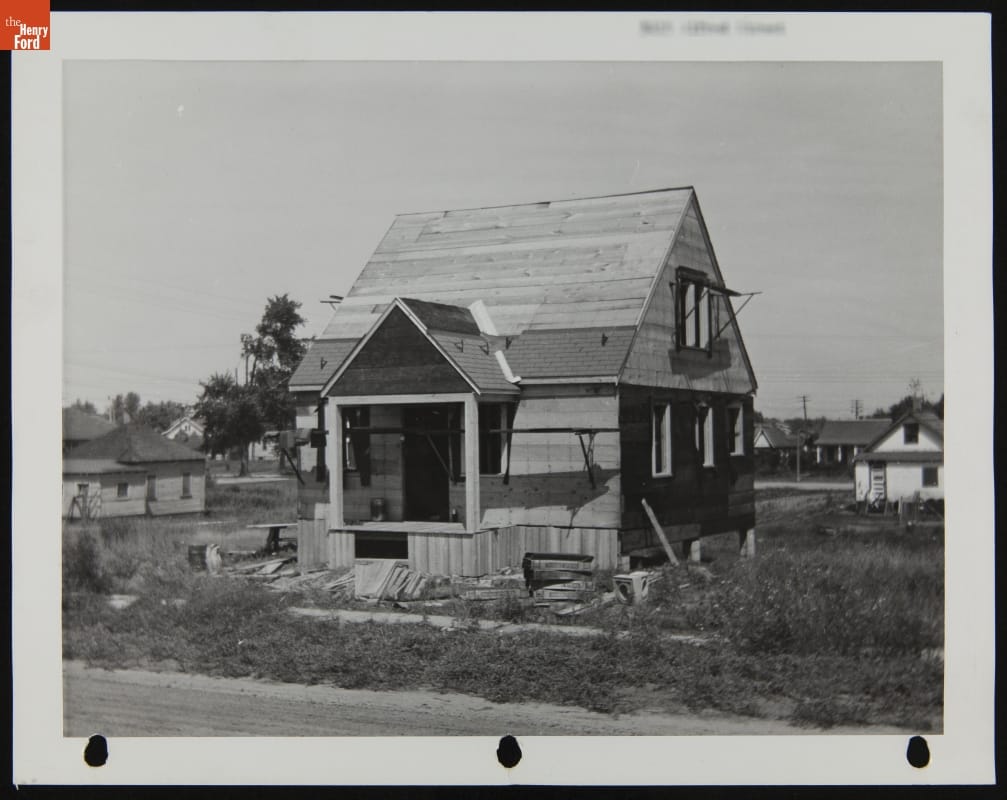
Photographic print - "Ford Motor Company Employee Home Improvement Project, Inkster, Michigan, 1930-1944" - Ford Motor Company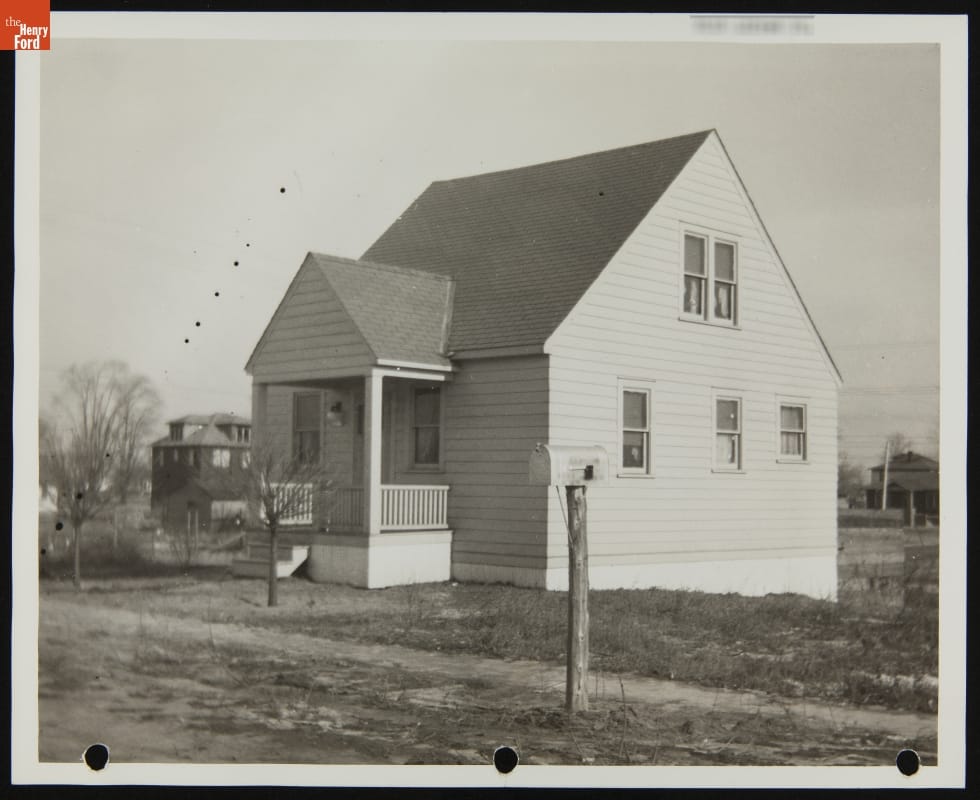
Photographic print - "Ford Motor Company Employee Home Improvement Project, Inkster, Michigan, 1930-1944" - Ford Motor Company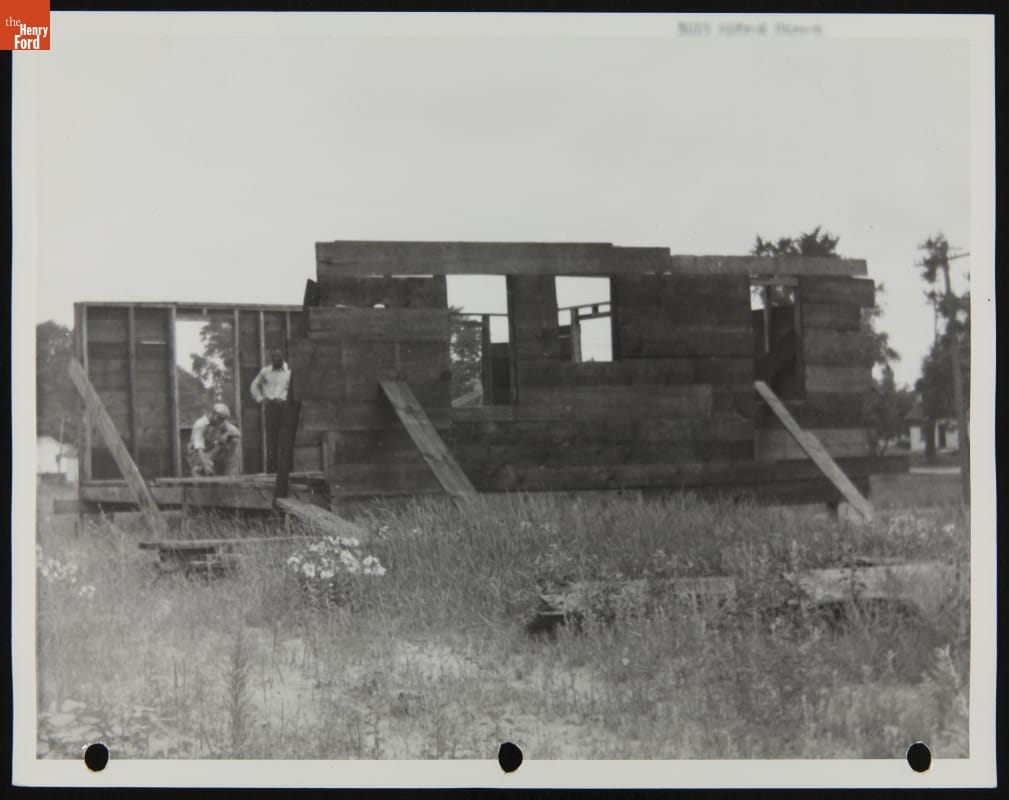
Photographic print - "Ford Motor Company Employee Home Improvement Project, Inkster, Michigan, 1930-1944" - Ford Motor Company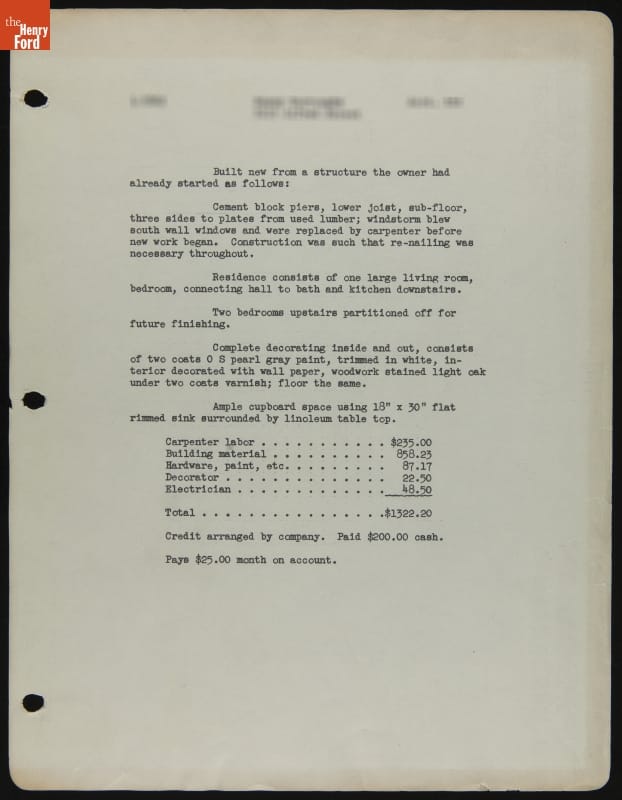
Report - "Ford Motor Company Employee Home Improvement Project, Inkster, Michigan, 1930-1944" - Ford Motor Company
By 1931, a few years into the Great Depression’s hardships, the residents of Inkster were struggling. Unemployment and debt were high, public services had been cut, and many residences remained partially-completed, as the Great Depression halted progress in the young village. Controversially, Henry Ford placed FMC’s Sociological Department in charge of what became known as the Inkster Project. The Sociological Department was created in 1914 in order to manage the diverse workforce and ensure employee adherence to the company’s strict standards, which were paternalistic in nature and often crossed the home life-work life boundary. In Inkster, the Sociological Department immediately began implementing programs to comprehensively rehabilitate the village. A commissary, which sold high-quality, low-cost food and essential home goods, was established. Coal was distributed to those who needed it to heat their homes. Debtors were paid off, and a medical clinic and school were constructed. Homes deemed insufficient were rehabilitated. The inability to pay for these services was irrelevant; a type of “I.O.U,” repayable through Ford-provided work and wages, was enough to access all life’s necessities.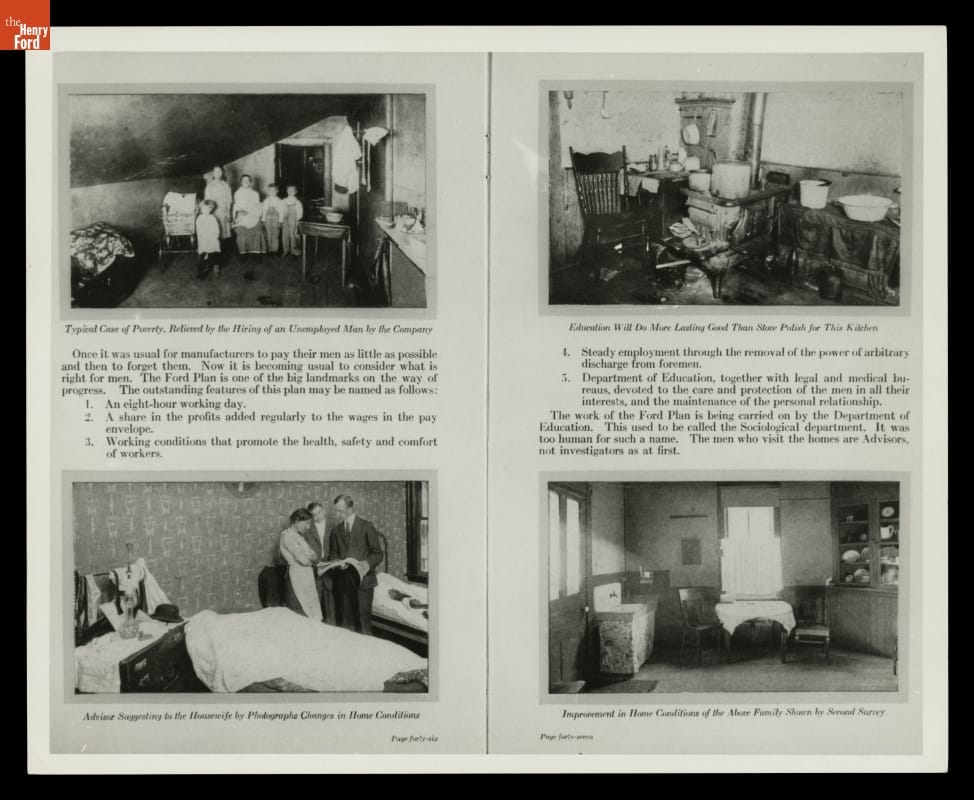
Photographic print - "Checking on Ford Employees Home Conditions, Views from "Factory Facts From Ford," 1917"
The Legacy of the Inkster Project
Although the Inkster Project was generally highly-regarded at the time, the FMC Sociological Department’s role was often overreaching. When agreeing to Ford’s aid, an Inkster resident was also agreeing to running their household as preferred by Henry Ford. Although his funds undoubtedly helped Inkster during the Great Depression, Ford’s motives were not entirely altruistic. Besides the much-needed public relations boost he received from the Inkster Project, he also was able to assert his influence and ideals on a community that largely had no choice but to accept his aid -- with all strings attached.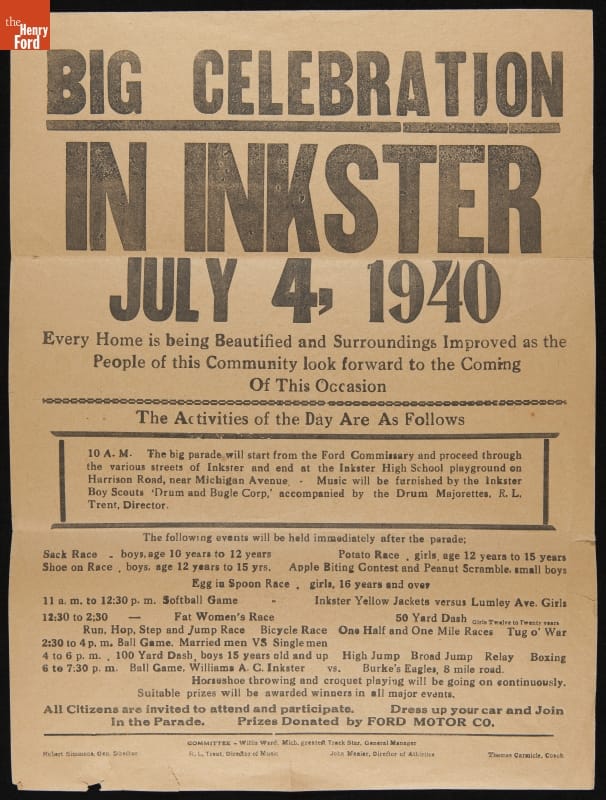
Broadside (Notice) - "Big Celebration in Inkster," July 4, 1940"
The Inkster Project’s legacy is complicated; many historians criticize Henry Ford’s paternalistic nature and the perhaps forceful imposition of his will onto the desperate, but others, including former residents of Inkster, praise Henry Ford for his aid. In her reminiscences, Georgia Ruth McKay explains that Inkster became a “jungle village changed into a city” during this period and that, “without his [Henry Ford’s] help, many would not have survived.” The Inkster Project was slowly phased out, but continued to operate in Inkster until 1941 when all programs were withdrawn.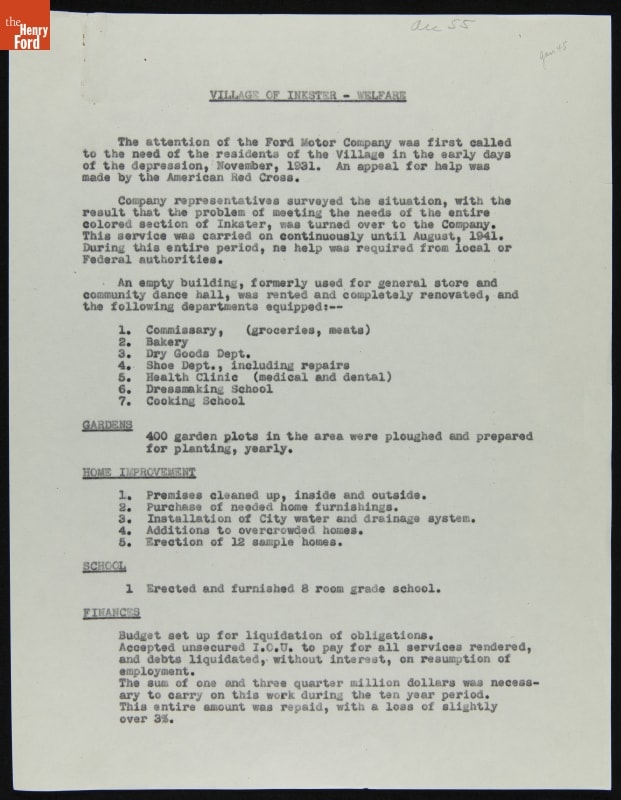
Progress report - "Village of Inkster Welfare Report, 1931-1941" - Ford Motor Company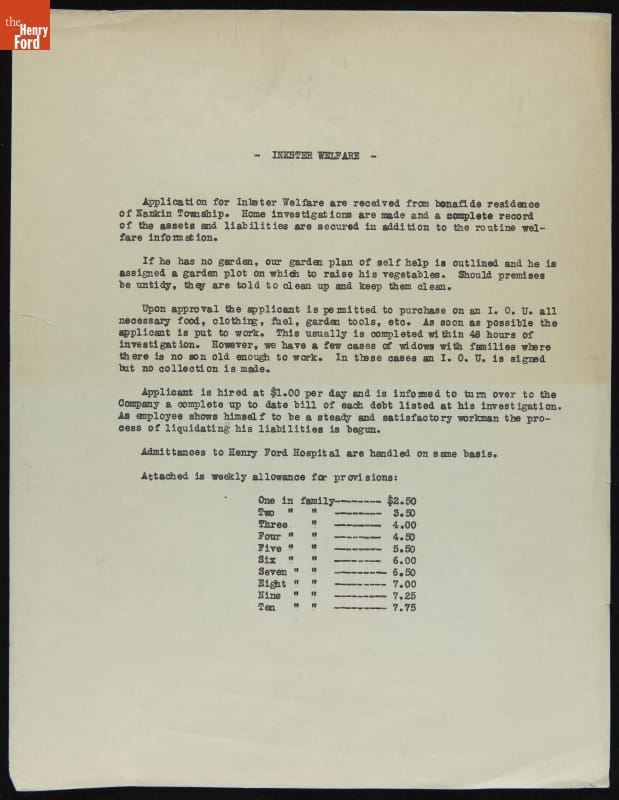
Report - "Village of Inkster Welfare Provision Report, circa 1936" - Ford Motor Company
Katherine White is Associate Curator, Digital Content, at The Henry Ford. In writing this piece, she appreciated the research and writings of Beth Tompkins Bates’ “The Making of Black Detroit in the Age of Henry Ford”, Thomas J. Sugrue’s “The Origins of the Urban Crisis; Race and Inequality in Postwar Detroit,”, and Howard O’Dell Lindsey’s dissertation, “Fields to Fords, Feds to Franchise: African American Empowerment in Inkster, Michigan.”
20th century, Michigan, labor relations, home life, Henry Ford, Ford workers, Ford Motor Company, Detroit, by Katherine White, African American history
Surprising Stories from IMLS Discoveries
 While researching the many electrical objects being digitized as part of the Institute of Museum and Library Sciences grant, a few stories have stood out to me. These stories sometimes involve the people behind the scenes: manufacturers, inventors, etc., and other times are about how the object was used. Below are four such objects and their stories.
While researching the many electrical objects being digitized as part of the Institute of Museum and Library Sciences grant, a few stories have stood out to me. These stories sometimes involve the people behind the scenes: manufacturers, inventors, etc., and other times are about how the object was used. Below are four such objects and their stories.
This Jenney Electric Motor Company rheostat has uncovered an interesting story about the company’s namesake. It was designed by Charles G. Jenney who was awarded a patent for it in 1892. Jenney, originally from Ann Arbor, Michigan, moved to Fort Wayne, Indiana with his father to design and produce electrical equipment for the Fort Wayne Jenney Electric Light Company. On February 27, 1885, Jenney, who had been contracted to the Fort Wayne Jenney Electric Light Company by his father while still a minor, successfully petitioned to be removed from the company, and, a month later, he founded the Jenney Electric Light Company later the Jenney Electric Company. The Jenney Electric Company was demonstrating Jenney’s dynamos, arc lamps, and incandescent lamps by August that same year. This company was bought out and Jenney started again, this time with the Jenney Electric Motor Company in 1889 for which he produced electrical equipment like this rheostat, filed for more patents, and wired and lit the streets of Indianapolis.
Continue Reading20th century, 19th century, power, IMLS grant, electricity, by Laura Myles
Glass Gallery x2

With the Davidson-Gerson Modern Glass Gallery opening in Henry Ford Museum of American Innovation last fall, Greenfield Village is the site for the next chapter in this exhibit's story.
The Davidson-Gerson Modern Glass Gallery is in Henry Ford Museum of American Innovation. It opened in October 2016. The Davidson Gerson Gallery of Glass is in Greenfield Village’s Liberty Craftworks District. Its grand opening is set for spring 2017.
Both galleries provide an in-depth look at the American glass story. The museum gallery focuses specifically on the studio glass movement of the 1960s, while the village gallery, supported by the Michigan Council for the Arts and Cultural Affairs, surveys the history of American glass, ranging from 18th-century colonial glass through 20th-century mainstream glass as well as studio glass.
Charles Sable, curator of decorative arts, was tasked with updating and reinterpreting The Henry Ford’s American glass collection. He envisioned creating an all-new gallery adjacent to the museum’s Glass Shop in the Liberty Craftworks District of Greenfield Village — a place to exhibit portions of the institution’s 10,000 glass artifacts currently in storage. His vision intersected with that of collectors Bruce and Ann Bachmann, who were seeking to donate their 300-piece studio glass collection.
According to Sable, the studio glass movement, which began in the early 1960s, is recognized as a turning point in the history of glass, as artists explored the qualities of the medium in a studio environment. Their goal was to create fine art. Evolving over a 20-year period, the movement matured in the 1980s with artists producing a myriad of unique works.
While other museums were interested in the Bachmann collection, it was The Henry Ford that garnered the collectors’ full attention and eventually their generous donation. “The Bachmanns had very specific criteria for their collection,” said Sable. “They were looking for an institution that was in an urban area, preferably in the Midwest where they live, had a large visitation, and was capable of exhibiting and maintaining the collection.
“As Bruce told me, it was a good marriage. He felt his collection would live here in perpetuity,” added Sable.
The story of the studio glass movement is now on permanent exhibition in the DavidsonGerson Modern Glass Gallery, which is located in the museum space that once showcased The Henry Ford’s silver and pewter collections. “Our exhibit is a deep dive into how studio glass unfolded,” said Sable. “It’s the story of the combination of science and art that created a new and innovative chapter in the history of glass.”
The exhibition also looks at the impact of studio glass on everyday life and includes a section on mass-produced glass influenced by studio glass and sold today by retailers such as Crate and Barrel, Pier 1 Imports and others.
Once the new Davidson-Gerson Gallery of Glass in Greenfield Village opens this spring, thousands of visitors will have an added opportunity to see larger-scale studio glass pieces from the Bachmann collection as well as the evolution of American glass.
DID YOU KNOW?
The Bachmann studio glass collection includes representation of every artist of importance in the movement, including Harvey Littleton, Dominick Labino, Dale Chihuly, Lino Tagliapietra, Laura Donefer and Toots Zynsky.
The gallery is a careful redesign of the McDonald & Sons Machine Shop in the Liberty Craftworks District.
BY THE NUMBERS
180: The number of glass artifacts on display in Henry Ford Museum of American Innovation’s Davidson-Gerson Modern Glass Gallery.
155: The number of artists represented in the Bachmann studio glass collection.
300: The number of studio glass pieces in the Bachmann collection
Additional Readings:
- Davidson-Gerson Modern Glass Gallery
- Beyond Favrile: Louis Comfort Tiffany and American Culture
- Western Interactions with East Asia in the Decorative Arts: The 19th Century
- Tiffany and Art Glass
21st century, 20th century, The Henry Ford Magazine, philanthropy, Henry Ford Museum, Greenfield Village, glass, decorative arts, art
Exposed Engine: 1913 Scripps-Booth Rocket Cyclecar

1913 Scripps-Booth Rocket
V-2 cylinder engine, air-cooled, 35 cubic inches displacement, 10 horsepower
Inexpensive cyclecars, as the name suggests, often used motorcycle engines like the V-2 in this Scripps-Booth prototype. The air-cooled motor meant there was no need for water or a radiator, while the splash lubrication system eliminated the necessity for an oil pump. The prototype’s engine is mounted with its crankshaft parallel to the rear axle, simplifying the belt connections between transmission and wheels.
1910s, 20th century, Henry Ford Museum, Engines Exposed, engines, Driving America, cars, by Matt Anderson
Exposed Engine: 1930 Ford Model A

1930 Ford Model A
Inline 4-cylinder engine, L-head valves, 201 cubic inches displacement, 40 horsepower
Painting engine blocks is a long-standing tradition among automakers. In the 1960s, Ford favored blue while Chevrolet preferred orange. But green was Ford’s color of choice when this Model A came off the line. The black enameled pipe, running diagonally along the block just below the carburetor, returns surplus oil from the valve chamber back to the crankcase.
Matt Anderson is Curator of Transportation at The Henry Ford.
Michigan, 20th century, 1930s, Henry Ford Museum, Ford Motor Company, Engines Exposed, engines, Driving America, cars, by Matt Anderson
Exposed Engine: 1926 Rolls-Royce New Phantom Limousine

1926 Rolls-Royce New Phantom Limousine
Inline 6-cylinder engine, overhead valves, 468 cubic inches displacement, 108 horsepower
Rolls-Royce’s New Phantom engine, introduced in 1925, featured twin ignition with two spark plugs in each of its six cylinders. Those cylinders were cast in two sets of three, coupled by a one-piece cylinder head. Great Britain taxed automobiles based on cylinder bore. To reduce its tax penalty, the New Phantom engine was “undersquare” with its 4¼ -inch bore smaller than its 5½-inch stroke.
20th century, 1920s, Europe, luxury cars, limousines, Engines Exposed, engines, cars, by Matt Anderson
Exposed Engine: 1931 Duesenberg Model J

1931 Duesenberg Model J
Inline 8-cylinder engine, double overhead camshafts, 420 cubic inches displacement, 265 horsepower
The Duesenberg is a beautiful automobile, and under the hood there’s plenty of go to match the show. The straight-8’s four valves per cylinder and duplex carburetor helped it pump out an enormous amount of horsepower for the time. (Later supercharged versions produced an astounding 320 horsepower!) The Model J could break 100 miles per hour without breaking a sweat.
Matt Anderson is Curator of Transportation at The Henry Ford.
20th century, 1930s, luxury cars, Engines Exposed, convertibles, cars, by Matt Anderson
Victor H. Green and “The Negro Motorist Green Book”

Green Book 1949 front cover. THF77183
“Where Will You Stay Tonight?”
Freedom. Independence. Hitting the open road without a care in the world. After years of being tied down to railroad schedules, motorists in the early 20th century used words like these to describe the joys of cross-country travel by automobile.
African Americans were as eager to purchase automobiles as anyone, to escape the indignities of “Jim Crow” laws that dictated segregated waiting rooms and railroad cars in the South, and to avoid more subtle—yet equally humiliating—forms of discrimination elsewhere. But the joys of motoring without care did not apply to them.
Sign from segregated railroad station, 1921. THF93445
For, once they stopped along the road—anywhere along the road in virtually any part of the country—segregation, discrimination, and humiliation returned in force. It was at hotels and tourist cabins that denied them lodging for the night; at restaurants, where they were turned away for meals or a cup of coffee; and at service stations, where requests to fill up with gasoline, repair a vehicle, or use the restroom were denied. According to Civil Rights leader Julian Bond, “It didn’t matter where you went—Jim Crow was everywhere.” Constantly alert to situations that might be humiliating, African-American motorists took to packing food, blankets, pillows, portable containers with gasoline, and old coffee cans or buckets to use as toilets. They made prior plans to stop overnight with relatives or friends, sometimes driving miles out of their way.
Even worse than segregation laws and customs, Black travelers had to constantly navigate a minefield of uncertainty and risk on the road. Would this place be safe to stop? Could my children use the bathroom here? African-American motorists faced the potential of physical violence, racial profiling by police (targeting individuals for crimes based upon their race), or forcible expulsion from whites-only “sundown towns” in both the North and South, with their laws insisting that non-whites leave city limits by dusk or face the consequences. Some African-American travelers did not make it to their destinations, they just disappeared. It is no wonder that the question, “Where Will You Stay Tonight?” was always top of mind.
Victor Green Addresses a Need
“The Negro Motorist Green Book” was the brainchild of Victor H. Green, a black postal carrier in Hackensack, New Jersey, who later moved to Harlem in New York City. As Green tells it, the idea for this guidebook came to him in 1932, when he decided to do something about his own frustrating travel experiences as well as the constant complaints he heard from friends and neighbors about difficult and painfully embarrassing experiences they had while traveling by automobile. Green modeled the guide after those created for Jewish travelers, a group that had long experienced discrimination at vacation spots. The first edition of The Green Book, produced in 1936, was limited to listings in New York City. But the demand for the guide was so great that, by the following year, it became national in both scope and distribution.

Green Book 1937 ed. THF99195
Although often including longer editorial features, at its heart The Green Book was a directory of safe places for African-American travelers, including hotels, motels, tourist homes (the homes of private individuals who were willing to offer a room for the night), restaurants, beauty and barber shops, service stations, garages, road houses, taverns, and nightclubs. The most prolific listings were in metropolises with large populations of black Americans, like New York, Detroit, Chicago, and Los Angeles. Perhaps more valuable to travelers were the listings in smaller towns far removed from these cities.
The Los Angeles listings in the 1949 Green Book were quite extensive compared to other California towns and cities.THF77190
Green collected the listings through his contacts in the postal workers’ union, as well as by asking Green Book users to submit suggestions. As the book became more popular, Green commissioned agents to solicit new business listings as well as to verify the accuracy of existing ones.
From his small-scale publishing house in Harlem, Green distributed the books by mail order, to black-owned businesses, and at Esso (Standard Oil) service stations—a rare gasoline distributor that franchised to African Americans. He sold copies at black churches, the Negro Urban League, virtually anywhere that African Americans were bound to encounter them.
The Michigan listings in the 1949 Green Book were most extensive in Detroit and the black resort of Idlewild. THF77203
Rise and Decline
Publication of The Green Book was suspended between 1942 and 1946, because of World War II, but it started up again in earnest with the postwar travel boom in 1947. Ever the entrepreneur looking for ways to aid African American travelers, Green branched out that year to create a Vacation Reservation Service, a travel agency that booked reservations at any hotel or resort listed in the book. That same year, he also issued a supplementary directory of summer resorts that welcomed black vacationers, called the Green Book Vacation Guide.
Left: An ad for The Green Book Vacation Guide in the 1949 Green Book. THF 77185
In 1952, Green retired from the postal service and became a full-time publisher. He renamed the guidebook “The Negro Travelers’ Green Book” to reflect the increasing popularity of international travel by ship and airplane. By 1955, the book was endorsed and in use by the American Automobile Association and its hundreds of affiliated clubs throughout the country, as well as travel bureaus, bus lines, airlines, travelers’ aid societies, libraries, and thousands of subscribers.
The market for The Green Book began eroding in the 1960s, especially after the Civil Rights Act of 1964 that legally prohibited racial segregation. Increasing numbers of middle-class African Americans began to question whether the book was actually doing more harm than good because it continued to encourage Jim Crow practices by steering black travelers to segregated businesses rather than encouraging integration. New, interstate-highway hotels, which were integrated, became preferable to detouring to black-owned lodgings in remote locations. The Green Book continued until 1966, published by Victor Green’s family after his death in 1960. Until the last year of publication, the book maintained that listing black-friendly businesses guaranteed hassle-free vacations for African-American families.
For 30 years, The Green Book protected African Americans from difficulties, indignities, and humiliation during their travels. Green charged only enough to make a modest profit. He never became rich; it was really all about helping out. In publishing this book, Green not only helped thousands of African Americans take more enjoyable vacations but also gave a tremendous boost to black-owned businesses across the country during the challenging Jim Crow era.
Peruse the entire 1949 “Negro Motorist Green Book” in our digital collections.
Continue Reading1950s, 1930s, 1940s, 20th century, travel, roads and road trips, entrepreneurship, cars, by Donna R. Braden, African American history
Exposed Engine: 1989 Honda Accord

1989 Honda Accord
Inline 4-cylinder engine, overhead camshaft, 119 cubic inches displacement, 98 horsepower
Using a front-wheel drive layout in a front-engine car allows for a compact design, but it requires some clever packaging under the hood. The Accord’s automatic transmission is combined with a differential into a single unit called a transaxle, mounted on the passenger side of the engine. The transverse-mounted engine has three valves per cylinder – two intake and one exhaust.
Matt Anderson is Curator of Transportation at The Henry Ford.
1980s, 20th century, Henry Ford Museum, Engines Exposed, engines, Driving America, cars, by Matt Anderson

